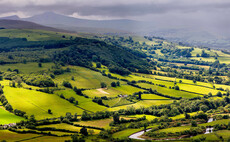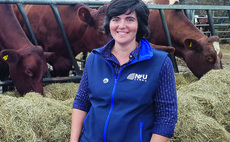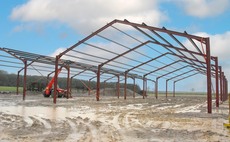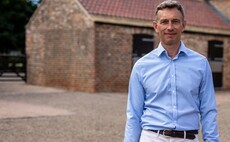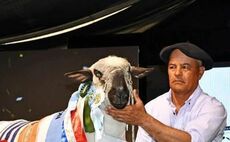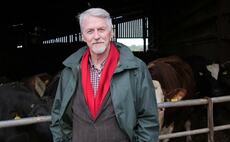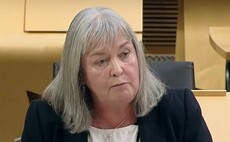
Since leaving a role with Rare Breeds Survival Trust a year ago, Ruth Dalton has been able to put time into developing her own farming interests, passion for native breeds and sustainable farming. Hannah Park finds out more.
A vision for encouraging wildlife to return while creating a more productive farm was central to Ruth Dalton and her partner, Andrew Walter, when they arrived at Whinpot Farm 16 years ago. Situated in Cumbria, just west of Kendal, Ruth and Andrew initially purchased 11 hectares (28 acres) of marginal, low fell land and put time and consideration into how they could improve infrastructure and grazing management.
Ruth says: "Bracken was our biggest challenge for the first five o r s i x y e a r s and there had been a lot of land lost to it. Water availability was also a major issue to overcome, as we wanted to sub-divide the land to be able to graze it better. But if we were going to do that we needed to get water everywhere, which at first could only be reliably sourced at one end of the site, so we made a small hydraulic ram pump to feed a couple of IBC header tanks and supply our troughs.
"Andrew had a great vision for how he wanted to encourage wildlife to return while creating a more productive farm.
"We spent hours looking at a map considering where we could put up fences. "In the end we applied for a woodland improvement grant which marked a turning point. We were able to deer fence off blocks of woodland, which created a patchwork of pasture separated by the woodland."
Improving land
Once the trees were planted, time and effort were put into restoring and improving areas of pasture in between.
"We used a bracken specific herbicide when we were allowed," says Ruth. "Using an old off-road Land Rover with a pickup back as the lack of level ground meant a tractor wasn't an option."
Their initial 11ha at Whinpot has since grown to 24ha (60 acres), after the opportunity to purchase some neighbouring land came up when the previous owners retired.
"The latest bit we bought two years ago has also taken some work to bring to fruition," says Ruth. "We have a lot of outcrop rock here and this area was no exception. But with some help from our neighbour we were able clear the worst of it and we have actually been able to start turning that into a species rich hay meadow which we are hoping to continue to develop."
Ruth adds that decision making on-farm has been independent of any environmental schemes, with the farm having not been part of any to date.
Biodiversity
"We've never been in any schemes apart from the woodland improvement grant, mainly because we're aware of how prescriptive they are and felt they wouldn't necessarily deliver for our livestock or biodiversity," she says. "However, we're considering our options right now with the phasing out of the Basic Payment Scheme (BPS) and will be interested to see what the Farming in Protected Landscapes programme has to offer [Whinpot is in the Lake District National Park]."
A 30-head herd of Shetland cattle is the couple's farming mainstay, which are kept alongside a cross-bred sheep flock derived originally from the Wiltshire Horn. There is also a handful of Manx Loaghtans, originally gifted to Ruth when she left Rare Breeds Survival Trust (RBST).
"The sheep we have suit us," says Ruth. "They're easy to maintain with good feet and will rear a good lamb of marginal quality grazing. We've been impressed with the Manx Loaghtans so far too. They're hardy and not an insignificantly sized primitive sheep."
Their sheep system sees a handful of ewes kept as replacements, while surplus females and wether lambs are finished and sold through the pair's box scheme which they mainly supply to family and friends. Beef is also sold direct, although some of the steers are sold at weaning to other farmers wishing to rear them on in a similar system.
"We started with the Shetland cattle because we wanted something small but not tiny," Ruth says. "I would describe them as a bit like an old-fashioned Shorthorn, they are a dual-purpose breed capable of rearing a good calf as they are very milky."
With help from the countryside productivity small grant scheme, Ruth and Andrew were also able to purchase a new crush with weigh bars which has facilitated closer monitoring for things such as growth rates.
"I was really chuffed that last year a lot of the calves at weaning at seven months had managed 1kg daily liveweight gain with their mothers on grass alone, which we attributed to the fact that they are such a milky breed," she says.
Calves are weaned at seven months in-line with a winter grazing arrangement the couple have for the cows, so that they can thrive without nutrient demand exceeding supply here.
"The cows are wintered on grazing agreements where we are fulfilling a brief to enhance biodiversity on that land," Ruth says.
"A lot of people we work with want to incorporate winter grazing with cattle to try to encourage wildflowers and invertebrates to thrive on their land in the summer. Our small native breed cattle are perfectly suited to being outside in the winter, grazing off deferred forage and rarely need any additional feeding. The arrangement also frees up ground at home for youngstock which need a bit better nutrition and has also allowed us to expand the herd."
Alternative
While developing their own farming interests at Whinpot, Ruth and Andrew both have work commitments off-farm as well. Andrew works for the Cumbria Wildlife Trust, while Ruth spent 10 y e a r s w i t h t h e RBST before leaving and taking a role as a part-time regional facilitator for PastureFed Livestock Association as well as working part-time with The Farmer Network.
Ruth has also started doing some freelance native breed consultancy - although this was not originally part of the plan.
"The RBST role helped hugely in nurturing my interest in native breeds and sustainable farming and I met some great people," she says. "I met such a range of farmers, from those who had lived and farmed in their locality for generations to others who were quite new to it but who were all doing great things when it came to land management, breeding and so on. To my surprise, when I left, I was contacted and asked whether I could give some advice on a freelance consultancy basis. I was a bit shy about putting myself out there at first, but it was a confidence boost at the same time."
She now advises farmers, land managers and breed societies throughout the UK on everything from breed choice, grazing management and specialist projects.
"Discussions I've had have included those around what breeds may be best suited to a particular set-up, advice on sourcing good quality, high health status stock or more generally, looking objectively at a farm system and breed decisions with the phase-out of BPS in-mind and helping people consider, for example, alternative marketing outlets," she says.
Success
Ruth describes herself as a specialist in matching the right breed to the right place and says discussions will bring to the table options people may not have previously considered.
"In the era of breed specific schemes, there seems to have been a focus on one or two hardy breeds, when many other native breeds that could do just as good a job have been forgotten so often it is a case of simply bringing them into the discussion," she says.
"Often farmers I speak to are interested in finding cattle to do a specific job and are open to suggestions of breeds they sometimes haven't heard of to do that. I've had some success stories with the British White recently, which is one cattle breed which has become undeservedly rare."

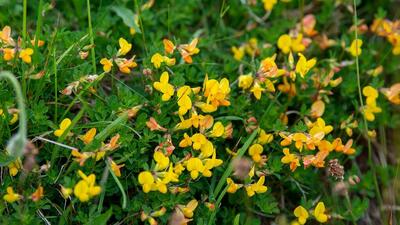
Farm facts
- Whinpot Farm spans 24ha (60 acres) of marginal, low fell land on the outskirts of Kendal, Cumbria
- Marginal, low fell land in the main which has been improved over time
- Woodland improvement grant facilitated deer fencing of blocks of woodland to create a patchwork of pasture in between
- 30-head herd of Shetland cattle kept alongside a small cross-bred sheep flock derived originally from the Wiltshire Horn plus several Manx Loaghtans







